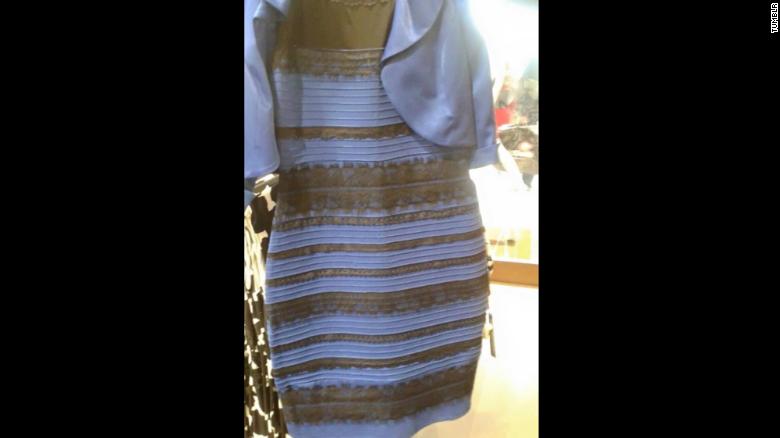Why blue/black/white/gold dress went viral 為什麼藍黑/白金洋裝會像病毒一樣到處被分享?

(CNN)There's
a simple reason why the dress debate and the rampaging llamas in Arizona have taken over our news feeds,
our conversations and our lives this week -- and it has more to do with cat
videos than science. To put it simply, we'd rather debate something positive,
like the dress, than ISIS and Department of Homeland Security funding.
為什麼關於這件洋裝的爭論和美國亞利桑那州暴怒的美洲駝會佔據這週我們的新聞版面、我們的對話和我們的生活,這裡有一個簡單的理由,而且這不只是(平常)一個貓咪影片或科學話題,簡單來說,我們寧可爭論一些正向議題,像是這件洋裝,勝過於ISIS和國安部資金。
This isn't
just speculation, it's a fact: What the majority of us read, share and discuss
is not "hard news"-oriented at all. A new study, led by applied
mathematicians at the University of Vermont and Mitre Corp., analyzed the emotional content of the news
we share online. And no matter the source of the news or the language, we use
positive words more and overwhelmingly share positive stories over the negative
news.
這並不只是猜測,這是一項事實:我們大部分的人都讀、分享、討論的事物完全不會是以「硬的新聞」為方向,一項新的研究,是由佛蒙特大學的數學家和Mitre公司所領導,這項研究分析這些我們在網路上分享新聞的情緒性內容,所以不論新聞的來源是什麼或是什麼語言,我們會用比較多正面的字詞,而且比起負面新聞,會無法抗拒的分享這些正面的故事。
And,
according to a study done by BuzzSumo, a content discovery and measurement
software company, the emotions that make a story go "viral" are not
fear and anger -- they are awe, laughter and amusement. Their analysis of
10,000 most viral articles proved this point overwhelmingly.
而根據一項BuzzSumo-一家內容探索與測量的軟體公司所做的研究,這些讓新聞內容變得「病毒」的情緒不是恐懼或是憤怒-而是驚嘆、笑容和娛樂,他們的分析是根據一萬篇像病毒一般被分享的文章,來證明這些論點。
Another
case: On Friday came news of Leonard Nimoy's death after a long and prosperous
life. Quickly, his most inspiring quotes, discussion of his influence on American culture -- not to mention
tributes of the Vulcan salute -- began trending all over the Internet as we
moved on from the dress and the llamas to bond over our shared awe and
admiration of a great man.
另一個個案:週五播報了李奧納德·尼莫伊在歷經漫長富裕的日子後辭世的新聞,很快的,我們焦點從洋裝和美洲駝轉移到他最鼓舞人心的名言、他對美國文化影響的討論-更不用說瓦肯舉手禮(註一),這趨勢完全席捲了網路世界,緊緊繫著我們對於一位偉人的敬畏和欽佩。
All this
doesn't mean we're uninterested in more intellectual topics -- it simply points
to a positivity bias in the stories we pay attention to most online. In
addition to the internal positive boost we feel, positive stories typically
help us feel connected to others. What's more amusing than looking at a dress is debating the dress with your friends and
family. And as we reflect on Nimoy's life, we can't help but reflect on a part
of our own, growing up with the shared experience across American culture of
watching "Star Trek."
這些並不代表我們對比較需要智力的主題比較不感興趣-這單單只是指出對正向新聞的偏愛,我們在網路上會花比較多時間關注;另外正向的內涵增加了我們的好感,正向的故事通常幫助我們感覺與他人產生連結,比看著洋裝更有趣的是和你的朋友和家人熱烈討論這件洋裝,而當我們想到尼莫伊的一生時,我們忍不住會想起我們自己的一部分,成長中有分享看「星際爭霸戰」的美國文化經驗。
As for the dress, by the way, neuroscientists who study color have an explanation for
why it appears to be blue and black to some of us, but white and gold to the
rest of us. In fancy terms, it has to do with the way in which light enters
your eye, the "chromatic axis" variation, thanks to daylight and the
fact that different colors have different wave lengths.
至於這件洋裝,順帶一提,研究顏色的神經科學家對於為什麼有些人看到的是藍黑色,但有些人看到的是白金色,有所解釋;用比較專業的講法,這是要看進入你眼睛裡的是什麼光線,「彩色軸」的不同,由於日光和不同顏色有不同的波長的事實。
There are a lot of technical terms to describe the phenomenon of
the dress, but I explained it to my 9-year-old this way: When we look at the
same object, our eyes and brains can make us see different things. It happens
with kale -- my husband and I see a delicious plate of greens; our kids see
something you should feed to those llamas that ran amok this week in Sun City,
Arizona. Voilà, the dress mystery has been solved. Unfortunately, that means we
can all go back to work now.
有很多專業用詞來描述這件洋裝的現象,但是我向我九歲的孩子這樣解釋:當我們看著同樣一個東西,我們的眼睛和大腦會讓我們看到不同的東西,這發生在我丈夫Kale和我在看一盤美味的綠色食物時;我們的孩子看到的是你應該要餵這些這星期在亞利桑那州太陽城暴衝的美洲駝,看看這!(註二)這件洋裝的謎團已經被解開,不幸的是,這代表我們現在必須要回到工作上了。
註一 瓦肯舉手禮(Vulcan salute) http://zh.wikipedia.org/wiki/%E7%93%A6%E8%82%AF%E4%B8%BE%E6%89%8B%E7%A4%BC
註二 Voilà (法文:That is; Here is; There is.)





